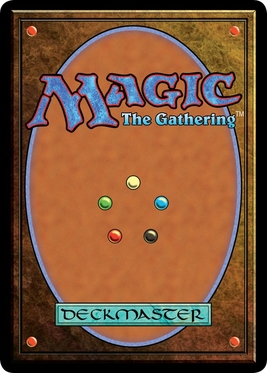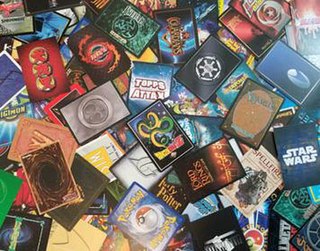
Magic: The Gathering is a tabletop and digital collectible card game created by Richard Garfield. Released in 1993 by Wizards of the Coast, Magic was the first trading card game and had approximately fifty million players as of February 2023. Over twenty billion Magic cards were produced in the period from 2008 to 2016, during which time it grew in popularity. As of the 2022 fiscal year, Magic generates over $1 billion in revenue annually.

A crossword is a word game consisting of a grid of black and white squares, into which solvers enter words or phrases ("entries") crossing each other horizontally ("across") and vertically ("down") according to a set of clues. Each white square is typically filled with one letter, while the black squares are used to separate entries. The first white square in each entry is typically numbered to correspond to its clue.
The Multiverse is the shared fictional universe depicted on Magic: The Gathering cards, novels, comics, and other supplemental products. Though Magic is a strategy game, an intricate storyline underlies the cards released in each expansion. On the cards, elements of this multiverse are shown in the card art and through quotations and descriptions on the bottom of most cards. Novels and anthologies published by HarperPrism and Wizards of the Coast (WOTC), and the comic books published by Armada Comics expand upon the settings and characters hinted at on the cards. WOTC also publishes a weekly story in the Magic Fiction column, previously known as Official Magic Fiction and Uncharted Realms.
Several video games based on the Magic: The Gathering franchise exist for multiple systems. Some have attempted to translate the card game to electronic play nearly exactly; others have taken more liberties and drawn more from the setting than the actual rules of the card game. Benefits of successful video game versions of the card game include convenience, practice, and challenge. However, artificial intelligence for a game such as Magic is an extremely hard problem, and such software usually must be continuously updated to stay current with recently released card sets. Video game versions often expand on artwork, and may include unique cards that rely on randomness, effects which would be difficult or annoying to duplicate in real life.

The 'Neopets TCG' is an out-of-print collectible card game and a spin-off of the popular virtual pet website, Neopets. The game was launched in 2003 and produced by Wizards of the Coast, a large trading card company that produces a variety of other trading card games. Neopets is aimed at a slightly younger audience than other Wizards of the Coast offerings such as Magic: The Gathering. As with many other trading card games, the cards serve two purposes, collecting and playing a game.
Unhinged is a humor and parody themed expansion set to the collectible card game Magic: The Gathering. Unhinged was released on November 19, 2004. Its tone is less serious than traditional Magic expansions. It is a follow-on to Unglued, an earlier humor themed expansion set. It was followed in turn by Unstable

Mark Rosewater is the head designer for Magic: The Gathering, a position he has held since 2003.
Unglued is a Magic: The Gathering expansion set, the first satirical, non-tournament-legal expansion set released. It came out in August 1998. Its symbol is a cracked egg. Among the themes of the set were chicken, dice rolling and multiplayer Magic games.
The Odyssey is a Magic: The Gathering expert-level block. It consists of a trio of expansion sets: Odyssey, Torment and Judgment.
The collectible card game Magic: The Gathering published seven expansion sets from 1993–1995, and one compilation set. These sets contained new cards that "expanded" on the base sets of Magic with their own mechanical theme and setting; these new cards could be played on their own, or mixed in with decks created from cards in the base sets. With Magic's runaway success, many of the printings of these early sets were too small to satisfy the rapidly growing fanbase. Cards from them became rare, hard to find, and expensive. It was not until Fallen Empires and Homelands that Wizards of the Coast was able to print enough cards to meet demand; additionally, Wizards of the Coast published Chronicles, a reprint set that helped fix many of the scarcity issues with the earliest sets.
The collectible card game Magic: The Gathering published nine base sets from 1993–2007, also referred to as core sets. The base sets were considered descendants of the original Limited Edition, and shaped the default setting and feel of Magic. These sets consisted entirely of reprinted cards. These cards were generally simpler than cards in expansion sets, omitting multicolored cards, and used only the original abilities and keywords of Magic such as Flying and Trample. This simplicity led to many cards from these sets being considered "staples" of deck design. All cards were given a white border to mark them as reprints, with a few exceptions. From Fourth Edition in 1995 onward, a new base set would come out once per two years in the spring or early summer; for tournament play, that set would be legal for two years in the Standard format until the next core set replaced it.
Perplex City was an alternate reality game (ARG) created by Mind Candy, a London-based developer in 2005. Adrian Hon was the producer, designer and director of the game's first and only season, in which players searched for "The Receda Cube", an artifact of spiritual significance to the inhabitants of a fictional metropolis known as "Perplex City" which had great scientific value. In the game, "The Cube" had been stolen and buried somewhere on Earth.
Games World of Puzzles is an American games and puzzle magazine. Originally the merger of two other puzzle magazines spun off from its parent publication Games magazine in the early 1990s, Games World of Puzzles was reunited with Games in October 2014.

The Harry Potter Trading Card Game is an out-of-print collectible card game based in the world of J. K. Rowling's Harry Potter novels. Created by Wizards of the Coast in August 2001, the game was designed to compete with the Yu-Gi-Oh!, Pokémon and Magic: The Gathering card games. Its release was timed to coincide with the theatrical premiere of the first film in the series. The game was praised for the way it immersed children in the Harry Potter universe. At one point the game was the second best selling toy in the United States; however, it is now out of print.
Portal is the name given to the three Magic: The Gathering starter level sets. The original Portal was released on May 1, 1997, followed by Portal Second Age on June 24, 1998 and Portal Three Kingdoms on July 6, 1999. The Portal set was inspired by Chinese mythology; Three Kingdoms in particular by the 14th century Chinese historical novel Romance of the Three Kingdoms by Luo Guanzhong.

Magic: The Gathering is a video game published by MicroProse in March 1997 based on the collectible card game Magic: The Gathering. It is often referred to as Shandalar after the plane of Shandalar, where the game takes place. The player must travel the land and fight random enemies to gain cards, and defeat five wizards representing the five colors. The player must prevent one color from gaining too much power, and defeat the planeswalker Arzakon, who has a deck of all five colors. Adventure and role-playing elements are present, including inventory, gold, towns, dungeons, random battles, and character progression in the form of new abilities and a higher life point total. An oversized version of Aswan Jaguar was included in the game box.

A game is a structured type of play, usually undertaken for entertainment or fun, and sometimes used as an educational tool. Many games are also considered to be work or art.
The rules of Magic: The Gathering were originally developed by the game's creator, Richard Garfield, and accompanied the first version of the game in 1993. The rules of Magic have been changed frequently over the years by the manufacturer, Wizards of the Coast, mostly in minor ways. However, major rules overhauls have also been done a few times.

A collectible card game (CCG), also called a trading card game (TCG) among other names, is a type of card game that mixes strategic deck building elements with features of trading cards. It was introduced with Magic: The Gathering in 1993.
Dungeons & Dragons: Adventures in the Forgotten Realms is an expansion set for Magic: The Gathering (Magic) released in July 2021. The world of the Forgotten Realms was created by game designer Ed Greenwood around 1967 as a paracosm for his childhood stories and premiered as a campaign setting for the Dungeons & Dragons (D&D) fantasy role-playing game in the Forgotten Realms Campaign Setting (1987). This expansion set is the third collaboration between Magic and D&D; both teams are part of Wizards of the Coast.









